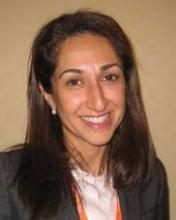SAN FRANCISCO – Several areas of active research are improving the outlook for adults with acute lymphoblastic leukemia, Dr. Partow Kebriaei told attendees of the annual Oncology Congress here.
Investigators are exploring the impact of treatment intensification, stem cell transplantation, use of minimal residual disease to guide therapy, and a host of new agents, according to Dr. Kebriaei of the department of stem cell transplantation and cellular therapy at the University of Texas M.D. Anderson Cancer Center, Houston.
More effective and less toxic treatments are especially needed in this age group, she explained at the congress, which is presented by Reed Medical Education. "We have had great success in eradicating acute lymphoblastic leukemia (ALL) in children but still have a ways to go in adults," Dr. Kebraiei said.
In particular, although both incidence and mortality increase sharply over the age of 50 years, the median age of enrollees in major ALL adult trials has been 30-40 years. "So one thing that we need to think about as we devise more new therapies is how to make them more tolerable or relevant to the older patient," she commented.
Intensified Treatment for Young Adults
The observation that younger adults with ALL, up to the age of 40, have better long-term remission when treated with the more intensive pediatric regimens vs. adult regimens has raised interest in this approach for adults generally, Dr. Kebriaei noted.
A trial of intensified chemotherapy in adults found a significantly better response rate, event-free survival, and overall survival compared with outcomes seen historically with standard-intensity chemotherapy (J. Clin. Oncol. 2009;27:911-8).
But in age-stratified analyses, any survival benefit among patients older than 45 was offset by higher treatment-related mortality. "So, for that older subgroup, treatment intensification still does not really impact outcome favorably," she said.
Additionally, a caveat for the younger adults was that the trial allowed crossover to transplantation for patients having a donor. "So it’s a little bit difficult to ascertain whether these improved results are from the availability of transplant or the intensification of treatment," Dr. Kebriaei commented. "But, I think in general, one can conclude that treatment intensification is effective up to a certain age."
Stem Cell Transplantation
The International ALL Trial assessed the role of stem cell transplantation in adults with ALL in first complete remission. Patients younger than 55 years of age having a sibling donor were allocated to allogeneic transplantation, whereas older patients or those without a donor were randomized to autologous transplantation or chemotherapy.
Among patients not having the Philadelphia chromosome, which confers poorer prognosis, those with a donor were less likely to have a relapse than were those without a donor, whether they had standard- or high-risk disease (Blood 2008;111:1827-33). But treatment-related mortality was increased; it canceled out the relapse benefit in the high-risk group, so that in contrast to the standard-risk group, there was no net improvement in survival.
The higher treatment-related mortality was mainly due to higher rates of infection and graft-vs.-host disease. "So if we want transplant to afford a better outcome to all patients, we are going to have to impact these complications," Dr. Kebriaei maintained.
Of note, in additional trial analyses, chemotherapy was associated with significantly better event-free and overall survival than autologous transplantation.
Efforts to reduce the treatment-related mortality of transplantation include reduced-intensity conditioning regimens that, for example, omit total-body irradiation. Studies of this approach have indeed found that compared with the standard one including total-body irradiation, it achieves a lower rate of deaths due to treatment, and among patients transplanted in first remission, similar overall survival.
"But the most important thing is that if you look at the median age of patients [in these studies], we are now approaching 55, which is more reflective of what we see in the clinic," she noted.
Use of MRD in Risk-Oriented Therapy
"Minimal residual disease [MRD] really defines a submicroscopic ALL and in patients that we would normally term as remission patients," Dr. Kebriaei explained. "It is evaluated by multichannel flow cytometry or PCR [polymerase chain reaction], and it’s really becoming one of the most significant prognostic markers that we have."
For example, in the International ALL Trial, persistent MRD after induction or early consolidation was significantly associated with an increased risk of relapse in patients receiving chemotherapy alone (Br. J. Haematol. 2010;148:80-9). Yet, that was not the whole story.
"Interestingly, here, when they looked at MRD in patients prior to going forward on allogeneic stem cell transplant, they did not see any impact of MRD," she noted. "They also didn’t see an impact of MRD in helping to predict which patients would develop CNS relapse."


